In this section, I will discuss some of the most important principles of combat from Jeet Kune Do. First I would like to talk about economy of structure. All techniques used in Jeet Kune Do involve taking the most direct route to the target with no wasted motion or energy. There is no chambering or retraction of the arm before the delivery of a punch, and no chambering of the leg before the delivery of a kick. Some might ask where the power comes from. It comes from the whole body!
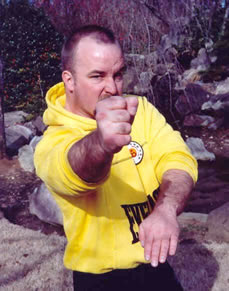 A prime example of this would be the Bruce Lee s famous one inch punch which he so often demonstrated to those who doubted the potential of a short range strike! He would start with his fist a mere inch away from a focus glove held against his demonstration partner s chest. With a sudden jolt of power like a surge of electricity went through his body, he would punch into the glove and send his partner flying back several feet. Often the person would fall down and even roll a few times from the impact! This is a prime example of using the entire body to generate striking force, not just the arm!
A prime example of this would be the Bruce Lee s famous one inch punch which he so often demonstrated to those who doubted the potential of a short range strike! He would start with his fist a mere inch away from a focus glove held against his demonstration partner s chest. With a sudden jolt of power like a surge of electricity went through his body, he would punch into the glove and send his partner flying back several feet. Often the person would fall down and even roll a few times from the impact! This is a prime example of using the entire body to generate striking force, not just the arm!
With the application of proper body mechanics, it is not necessary to draw back the arm before delivery of a strike. This negates the necessity of chambering the fist before delivering a punch. Without the chamber, or any preparatory retraction of the hand, it is much harder for an opponent to see a strike coming! Bruce Lee once said that you should be able to strike from wherever the tool (he referred to the hands and feet as the tools of the trade ) may happen to be without repositioning. This goes a long way toward assuring that you land the strike successfully!
The same principles apply to the delivery of a kick. In Jeet Kune Do, there is no chambering of the leg before the delivery of a kick. The idea is for the foot to go straight from where it is to the target without any preparatory repositioning. This makes it much harder to see coming and much harder to block, parry or intercept! Where does the power come from? Proper use of the waist, hips and correct footwork for the range of execution. Due to this directness, Jeet Kune Do kicks are extremely fast and deceptive!
When striking, you must figure out the most direct way to strike the target. To assist with this, we have a principle referred to as water in the hose ! Have you ever seen what happens when water from a fire hydrant is turned on full blast and the water surges into the hose? The force of the water causes the hose to suddenly jerk to a straight position in the direction that the water is flowing! This happens very quickly!
 When striking an opponent, imagine that your shoulder is the opening from the hydrant and the water is going to flow in the direction of your target. When the hydrant is turned on, your arm, forced to do so by the powerful surge of water, shoots straight as an arrow to the target that you are intending to strike! This is the most direct way to strike the target! If you can really use your imagination and feel the water surge into your arm, your speed will be greatly enhanced also! Your arm will shoot out to the target just like the fire hose when the water pressure hits it!
When striking an opponent, imagine that your shoulder is the opening from the hydrant and the water is going to flow in the direction of your target. When the hydrant is turned on, your arm, forced to do so by the powerful surge of water, shoots straight as an arrow to the target that you are intending to strike! This is the most direct way to strike the target! If you can really use your imagination and feel the water surge into your arm, your speed will be greatly enhanced also! Your arm will shoot out to the target just like the fire hose when the water pressure hits it!
This principle is also applied in kicking! In fact, probably even more so! This time the opening in the fire hydrant is the hip joint. Once again the water is surging directly toward your target! Allow the leg to jerk straight to the target, as if hit by the powerful surge of water! If done properly, you should feel the powerful snap at the completion of the kick, just as if the water was really there! This will enable you to impart maximum force to the target!
The principle of water in the hose gets the strike there. It is a principle which we refer to as the whip principle that gets it back! Have you ever held a whip in your hand and attempted to crack it at sometime in your life? Most of us have! Do you remember that sudden snap as the whip reached full extension and how quickly the whip returned?
Assume your on guard position and prepare to deliver a finger jab. Slowly extend the finger jab out toward your intended target. When the finger jab reaches its fullest extension, just pause and hold it there. Now visualize the whip cracking. Imagine that strong, jolting snap as it cracks and returns toward you faster than it went out! Now, still holding your finger jab at full extension, try to transfer what you just imagined to your arm and snatch the finger jab back as quickly as you possibly can, as if it were the whip and it had just cracked! Do this several times and get the feel of it, using your imagination to its fullest potential. Next do the same thing with a side kick and a hook kick extended to about waist height. Snatch the foot back as quickly as possible, imagining the crack of the whip! Be sure to return immediately to the on guard position each time!
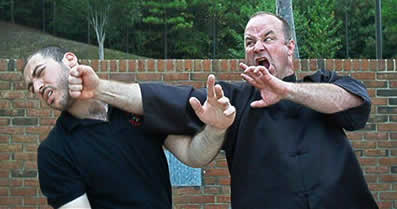 Now that you have experimented with both water in the hose and the whip principle, attempt to put the two together! Using water in the hose to get the technique out there and the whip principle to get it back, this will the lead to the fastest, most explosive strikes possible! Start of slowly with your experimentation so you don t pull anything! Attempt to apply these principles to all your hand strikes and kicks. You will find that they work better for some strikes and kicks than others, but you are definitely better off having learned to apply these principles to your techniques!
Now that you have experimented with both water in the hose and the whip principle, attempt to put the two together! Using water in the hose to get the technique out there and the whip principle to get it back, this will the lead to the fastest, most explosive strikes possible! Start of slowly with your experimentation so you don t pull anything! Attempt to apply these principles to all your hand strikes and kicks. You will find that they work better for some strikes and kicks than others, but you are definitely better off having learned to apply these principles to your techniques!
Another extremely important principle is placing the power side forward. In other words, the hand that you hit the hardest with is placed to the front, where it is closest to the opponent and can best be used. Besides, if either hand needs more distance to travel to generate force, it is your weaker side. Jeet Kune Do means the way of the intercepting fist . With your power hand forward you can intercept an opponent with knockout force!
For many years, tradition dictated that you should place the power side to the rear and the weaker side up front. The idea being to use the lead hand as your primary defense tool while reserving the rear, stronger hand for the killing blow ! If you think about it, it really doesn t make sense! Your weaker hand is closer to the opponent where it can easily strike, yet the power hand is further away where the opponent has more time to see it coming! More time to see it coming translates as more time to block, parry or simply get out of the way!
 Think of this as if we were talking about firearms. This is like having a .22 caliber handgun positioned so that you can t miss with it and a .44 caliber handgun positioned so that you don t have time to effectively use it! Why not place the power side to the front? Then the rear, weaker side has more travel distance to generate power! Now you have two .44 caliber handguns! I refer to this as the two gun theory. Why only have one effective gun when you could have two? Think about it! It really makes sense!
Think of this as if we were talking about firearms. This is like having a .22 caliber handgun positioned so that you can t miss with it and a .44 caliber handgun positioned so that you don t have time to effectively use it! Why not place the power side to the front? Then the rear, weaker side has more travel distance to generate power! Now you have two .44 caliber handguns! I refer to this as the two gun theory. Why only have one effective gun when you could have two? Think about it! It really makes sense!
Another important principle in Jeet Kune Do is the use of the longest weapon to strike the nearest target. This enables you to intercept an opponent at the earliest opportunity! Of course, your longest tool is your leg. The longest leg weapon is the leading shin/knee side kick, so this would be you obvious kicking choice. The longest hand weapon is the leading finger jab, so this would be your obvious striking choice. If you can disable an attacker quickly with the use of such tools, the fight is already won!
The next principle that I want to discuss is that of non-intention . In other words, the ability to strike without giving away your intention to do so! Unfortunately, this is much easier to talk about than it is to do! Patrick Strong, who is a very close friend of mine and an original JKD student from the Seattle period, has taught me much about non-intention. He said that Bruce used to use the example of a set of keys lying on the edge of a table to describe non-intention. If someone bumps the table and the keys fall off, do they just fall off or do they think about falling off, pause for a moment, and then fall? Of course, we all know that keys can t think, but it s the principle that is important here! Of course, the keys just fall off!
It should be the same way when you strike! When an opening suddenly exists, you should just strike! You shouldn t have to think about it before you strike. If you do, the moment is gone and your chance to strike is lost. Have you seen the fully restored version of Enter The Dragon with the scene where the main character is talking to the monk in the garden? There is a part of the conversation where Bruce Lee says, I do not hit! It hits all by itself! This is a prime example of non-intention!
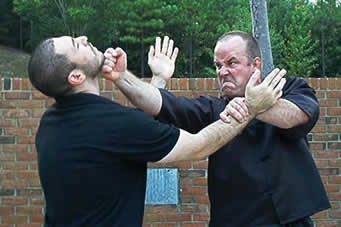 Next I will explain the centerline principle. This is taken from the wing chun system of Chinese gung fu. The centerline is an imaginary line that runs right down the center of the body. On this line, or slightly off to either side of this line are the targets where someone can strike you and do the most damage, such as the eyes, nose, throat, solar plexus and groin. What this basically tells us is that we should make all effort to protect our centerline while at the same time attempting to exploit any openings on the opponent s!
Next I will explain the centerline principle. This is taken from the wing chun system of Chinese gung fu. The centerline is an imaginary line that runs right down the center of the body. On this line, or slightly off to either side of this line are the targets where someone can strike you and do the most damage, such as the eyes, nose, throat, solar plexus and groin. What this basically tells us is that we should make all effort to protect our centerline while at the same time attempting to exploit any openings on the opponent s!
Another reason that impact to the centerline is more damaging is the fact that it is basically the center of your mass! Do a little experiment with your training partner. Stand facing each other squarely. Take turns extending your arms and pushing on each other s shoulders. You will notice that the body pivots on its central axis and most of the force is deflected. Now push each other right at the center of the chest. You will find that if you don t step back rather quickly you will fall! The body is forced to absorb much more impact from a blow delivered directly into the centerline!
To better protect the centerline, as well as be better prepared to attack any opening on the opponent s centerline, we have the bai jong, or on guard position. The best way to describe the bai jong position is to individually describe the elements that make it such an effective fighting stance. They are as follows:
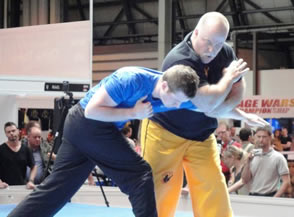 Now I will explain the theory of facing. When engaged in combat with an opponent, you assume the bai jong by lining up your centerline with their central line, also sometimes referred to as the motherline. The term central line is used to describe where their center of mass is located, as they might not face you with their centerline exposed. This method of facing the opponent enables you to place yourself in position to protect your centerline from any attack they might attempt. This also assists you with getting the proper foot alignment in relation to the opponent s position. This is extremely important, as improper stance alignment can offset your balance and take away your torque capability, rendering your footwork and attacks useless!
Now I will explain the theory of facing. When engaged in combat with an opponent, you assume the bai jong by lining up your centerline with their central line, also sometimes referred to as the motherline. The term central line is used to describe where their center of mass is located, as they might not face you with their centerline exposed. This method of facing the opponent enables you to place yourself in position to protect your centerline from any attack they might attempt. This also assists you with getting the proper foot alignment in relation to the opponent s position. This is extremely important, as improper stance alignment can offset your balance and take away your torque capability, rendering your footwork and attacks useless!
Next I will discuss the four corner theory. This is another theory from wing chun. The four corner theory is basically a way of simplifying defense of the upper body. One you understand the four corners and the accompanying defensive movements, defense of the upper body becomes a much easier task! To define the four corners, we split the upper body into four sections. To do this, we use the centerline and a horizontal line going right through the solar plexus. The top of the head is the highest point and the groin is the lowest point. Now we go two inches outside either shoulder and this defines the outer range of movement for defensive maneuvers. Now we clearly have four corners! They are the upper right side of the chest, shoulder and face, the upper left side of the chest, shoulder and face, the right side abdomen and hip and the left side abdomen and hip.
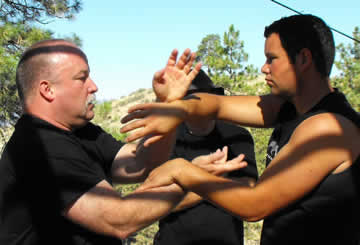 The specific definition of each corner is based on the side that is closest to the opponent. If you are facing the opponent in a right lead, your right upper corner is referred to as the outside high corner. Your right lower corner would be the outside low corner. Your left upper corner would be the inside high corner. Your left lower corner would be the inside low corner. Thus, the four corners are outside high, outside low, inside high and inside low. The next step is to learn the specific defensive movements designed to protect each corner. As you can see by now, this greatly simplifies your defensive strategy!
The specific definition of each corner is based on the side that is closest to the opponent. If you are facing the opponent in a right lead, your right upper corner is referred to as the outside high corner. Your right lower corner would be the outside low corner. Your left upper corner would be the inside high corner. Your left lower corner would be the inside low corner. Thus, the four corners are outside high, outside low, inside high and inside low. The next step is to learn the specific defensive movements designed to protect each corner. As you can see by now, this greatly simplifies your defensive strategy!
Although attack is preferred in Jeet Kune Do, sometimes defensive maneuvers become necessary. While other methods train to block an incoming attack, the Jeet Kune Do practitioner prefers to intercept, evade or parry the attack. Let s examine each of these defensive strategies.
The block is the least preferred method of defense, and is only used as a last resort! Why, you ask? Because blocking is the least efficient! When you block, you are using physical force of your own to stop physical force from the opponent. Not only is this a waste of your energy, but often also causes injury to a limb. Conserve your energy for the attack. Block only if it is the last resort to avoid being hit in a vital spot!
Interception is the preferred method of defense! You can intercept on intention (before their attack), on initiation (as they start their attack) or during execution (after the attack is on the way). Interception on intention is the ultimate, but usually requires years of training to develop almost a sixth sense ! It is not an easy task to read when an opponent is about to attack! One of my instructors, Sifu Steve Golden, is a master of this!
 There are several ways to intercept an opponent. With the upper body, the most common interception tools are the leading straight punch and the leading finger jab. With the lower body, the most common interception tools are the leading side kick, leading straight kick, rear leg oblique kick, inside angular stop kick and outside angular stop kick. What is a stop kick? Any kick used to stop an opponent s aggression toward you is a stop kick. Some have erroneously believed that it is a kick used to stop a kick, but it is a kick used to stop any part of the opponent s anatomy!
There are several ways to intercept an opponent. With the upper body, the most common interception tools are the leading straight punch and the leading finger jab. With the lower body, the most common interception tools are the leading side kick, leading straight kick, rear leg oblique kick, inside angular stop kick and outside angular stop kick. What is a stop kick? Any kick used to stop an opponent s aggression toward you is a stop kick. Some have erroneously believed that it is a kick used to stop a kick, but it is a kick used to stop any part of the opponent s anatomy!
Evasion is simply avoiding an attack. Evasion is extremely economical, as no contact whatsoever occurs with the opponent. Evasive movements can involve footwork of just body movement. Examples of evasion using footwork are the sidestep and the rear pendulum. Evasive movements using just the body or combining footwork with body movement are the duck, the snapback, the slip and the bob and weave.
A parry is a redirection of incoming force. The parry is very efficient, as you can attack simultaneously with the parry, or the parry itself can become the attack. When the parry becomes the attack, it is referred to as a riposte. This is a term from fencing, which Jeet Kune Do's development drew heavily from. When one hand parries as the other attacks, it is referred to as lin sil die dar, which is Chinese for simultaneous defense and attack. In lin sil die dar, the parry can make contact just before, right as or just after you land the strike. This is another highly effective skill that requires much training to develop.
The principle of the immovable elbow comes from wing chun gung fu. This principle states that the lead elbow should be at least a fist s distance (four to six inches) in front of the lead side ribs at all times. Never should you allow it to be resting against the body or out to the side of the body. Against the body it is in what we refer to as a pre-pinned position, making it easier for someone to trap your lead arm. If the elbow is out to the side the lead side ribs are left wide open and it is much harder to protect the centerline. It is also easier to deliver a non-telegraphic strike with the lead hand if the elbow is leading the body.
Another Jeet Kune Do principle that makes maximum use of the immovable elbow principle is the hammer principle. Application of the hammer principle greatly increases your non-telegraphic striking capability. The hammer principle is actually quite simple, though not often simple to apply. Most people still telegraph when trying it, even though the idea is to eliminate all telegraphic signs that a strike is on the way. The two most common strikes that this principle is applied to are the leading finger jab and the leading straight punch, both highly effective strikes when properly executed. You just have to really work at it a lot to get it down. Once you ve got it down, though, you ve really got something!
In explaining how this principle works, I will start from the beginning. Have you ever noticed that when you use a hammer to drive a nail, all or most of your arm movement is from the elbow out? This is what keeps the hammer accurate, right? If you don t believe this, try hammering with the whole arm and you will notice a sudden decrease in accuracy, especially if you hit your thumb! This motion from the elbow out only is where the term hammer principle comes from. When applying this principle, the arm movement is basically the same, from the elbow out.
If you are an experienced martial artist or boxer, usually when you are in your stance you keep your lead arm moving constantly. This will usually be small circling, rising/falling or weaving motions, right? I m sure that you also realize that these small motions go a long way toward concealing the initiation of your punch. If the arm is already moving, there is no start-up movement for the opponent to see.
Now, this is where the hammer principle comes into play. When you are making these small motions, keep your lead elbow in the same spot. In other words, nothing is moving except for the forearm, wrist and hand. Think of the immovable elbow theory that was covered in the previous section. The lead elbow is approximately four to six inches in front of the lead side ribs. This is the position where the hammering type movement comes from.
Now to execute the strike, drop the lead arm to a level where the forearm is pointing straight at the opponent s nose and let it fly. If done properly, this motion will completely conceal your intentions to strike. This is what is referred to as dropping the hammer . I witnessed Bob Bremer, who is one of the original L. A. Chinatown students, get in repeatedly on a much younger opponent with this maneuver! And that was after Bob had recently suffered a heart attack! Another thing that has to be considered here is that the opponent knew exactly what Bob was going to do, yet Bob repeatedly got in and touched his forehead with a bil jee before he could do anything about it! This proves the effectiveness of the hammer principle! Of course it also helps that Bob learned it directly from the master!
I like to use this analogy. Think of yourself standing on the sidelines watching an archery match. When the archer releases the arrow, you can follow it all the way to the target. Now imagine that same scenario, except for this time you are the target. The arrow would go through your face before you even realized that it had been released! Directness is the key here!
I have also referred to this principle as aiming the gun to help my students better understand it. Imagine that the forearm is the barrel of the gun. The fist or finger jab is the bullet. Wherever you aim the gun, the bullet goes, right? If the gun is already aimed, it is ready to fire. I teach my students to track the opponent s nose with their lead hand. This greatly simplifies interception! You are like the archer waiting for the proper time to release your arrow! Although it takes much work to get it down, mastery of the hammer principle is well worth the effort! Now you can see why it is such an important part of Jeet Kune Do strategy!
Although many of these principles are unique to Jeet Kune Do, they can be adapted to almost any martial art to improve the effectiveness of the practitioner! After reading about these principles it is easy to understand why Bruce Lee was such an effective martial artist. As he would say, Learn the principle, abide by the principle, then dissolve the principle! In other words, the principle becomes a part of you!